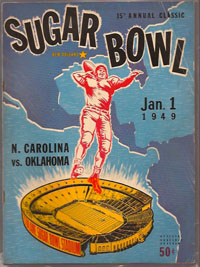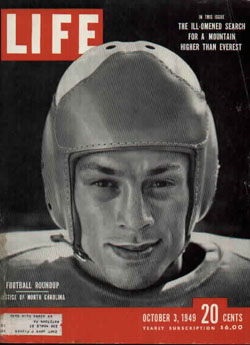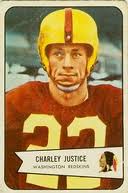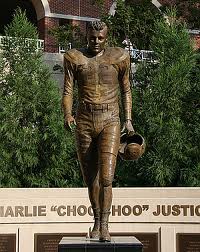Don Shula - I
Don Shula was an Ohio boy through and through.
- Son of a Hungarian immigrant, he grew up in a suburb of Cleveland. He played football at John Carroll College in nearby University Heights OH.
- The hometown Browns drafted him in the ninth round in 1951 as a DB. Since his coach at Carroll had used the Browns' playbook and terminology, Shula had an advantage, becoming the only rookie to make the opening day roster.
- After two seasons, legendary coach Paul Brown sent Shula to Baltimore in a monumental trade involving 15 players.
- Don played for the Colts for four years under Weeb Ewbank, a former assistant under Brown. Shula finished his playing career with one season as a Redskin.
Shula moved to the top of the coaching profession quickly.
- He began as a DBs coach at Virginia for one season before taking the same position at Kentucky, where his boss was another Brown disciple, Blanton Collier.
- In 1960, Don moved to the NFL not as a defensive assistant but as D-coordinator for Detroit, whose coach, George Wilson, would later precede Shula as head man of the Miami Dolphins.
- The Lions D moved up from 8th in the league in points allowed to third in just one season.
After only three seasons in Detroit, Shula was hired by Colts' owner Carroll Rosenbloom to replace Ewbank as his head coach.
- Veteran DE Gino Marchetti recommended Shula to Rosenbloom. "You mean that guy who used to play DB here?" Carroll asked.
- Gino, the leader of the Colts D from the time Shula had been his teammate, was impressed by the Detroit D in their twice annual meetings, recognizing the imprint of the Colts' own philosophy.
- Don recalled:
That's what helped me get credibility in the eyes of these guys I used to play with, who were much better players than I was. All of a sudden I'm going back there to coach them, and I'm just thirty-three years old.
It took just two years for Shula to put Baltimore in the NFL championship game again.
- Marchetti's support gave the young coach instant credibility with most of the veterans on the team.
- The toughest nut to crack, though, was All-Pro QB Johnny Unitas, who had told the departing Ewbank "I love you" to the great surprise of nearby teammates, unaccustomed to overt expressions of emotion from their leader.
- Marchetti:
Early on, it was fourth down and a half yard to go, and Shula sent in the FG team. John waved it off and got the first down. After the game, Shula summoned John to the coaches' room. I was a player-coach then, so I was there, too. We were the only three in the room. You have to know, Shula was a screamer, but he wasn't screaming now. He was very calm, quiet. "Listen, John," he said. "If you're going to show me up like that, I can't be the coach of this team. From now on, when I send the FG or the punting team in, you come off. It has to be my decision whether we kick or not." I turned to Unitas and said, "John, he's right."
- Shula's staff included Unitas in the game planning each week. Still, the man famous for his field generalship, bristled when the staff sent in sugggestions. OT Jim Parker recalled:
At the exact moment that John had been setting up and pointing to all game long, a play would come in from Shula. In the huddle John would say, "We're not running that play. We're running this play. Don't let me down."
Still, it took just two years for Shula to put Rosenbloom's team in the NFL title game again.
- After an improvement of just one game to 8-6 in '63, the Colts jumped to 12-2 in '64 and won the West Division. (Yes, Baltimore on the East coast played in that division because they replaced the Dallas Texans in 1953.)
- Baltimore faced Shula's original team, the Browns, now coached by Collier after new owner Art Modell forced Paul Brown out in a script similar to the one that brought Shula to Baltimore.
- Cleveland coasted 27-0 for the title, the franchise's last to this day.
The Colts would replace its aged members with young talent and stay competitive.
- A 10-3-1 mark in '65 tied Green Bay for first place in the West. But Vince Lombardi's team won the playoff 13-10 in OT when RB Tom Matte started at QB because of injuries to both Unitas and backup Gary Cuozzo.
- After slumping to 9-5 in '66, the Colts tied Los Angeles at 11-1-2 in the Coastal Division of the expanded NFL. However, the tie-breaker put the Rams in the playoffs.
1968 produced the best record in Baltimore history.
- With 34-year-old Earl Morrall engineering the O and an ailing Unitas on the bench, the Colts lost only to the Browns, 30-20, for an 11-1 regular season record.
- They beat the Vikings 24-14 in the first round of the playoffs, then demolished the Browns 34-0 for the NFL championship and a spot in Super Bowl III.
Anyone with even a passing acquaintance with football history knows what happened next.
- Considered by some as one of the finest teams ever, the Colts entered the game against the New York Jets as heavy favorites, up to 18 points in some quarters.
- As luck (or irony) would have it, the Jets' coach was none other than Weeb Ewbank. Weeb's brash young QB, Joe Namath, guaranteed victory and backed up his words, as the Jets bedeviled the Colts 16-7 to give the AFL credibility as it merged with the NFL.
- Ewbank's knowledge of his former team has not been given enough credit in explanations of the upset.
No one knew it at the time, but that was the beginning of the end for Shula in Baltimore.
Continued below ...
|
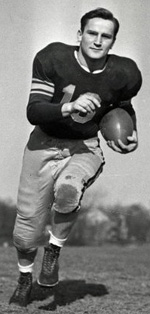
Don Shula, John Carroll
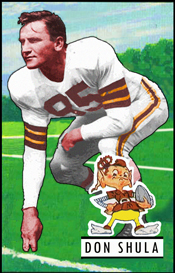
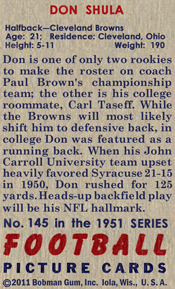

Weeb Ewbank
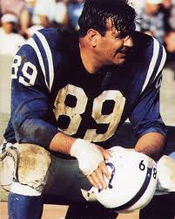
Gino Marchetti
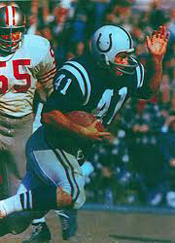
Tom Matte
|
References: Johnny U: The Life & Times of John Unitas, Tom Callahan (2006)
Top of Page
|
Don Shula - II
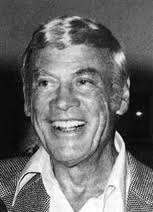
Carroll Rosenbloom

Joe Namath and Bear Bryant
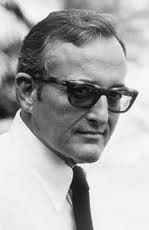
Edwin Pope
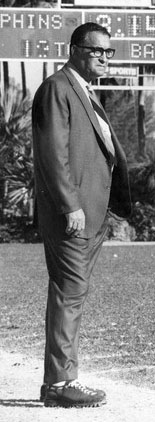
George Wilson
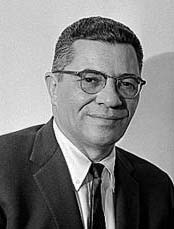
Vince Lombardi

Paul Brown and Don Shula
after 1973 playoff game
|
"The Greatest Upset in Sports History" in Super Bowl III left Baltimore coach Don Shula stunned.
- The game defined Joe Namath's career forever after. He made the Pro Football Hall of Fame despite the fact that he never won another playoff game.
- Conventional wisdom decreed that Weeb Ewbanks and his Jets staff had completely outcoached Shula's staff.
The loss also changed Shula's relationship with his owner, Carroll Rosenbloom.
- The 1969 Colts finished 8-5-1, good for 2nd place in the NFL Coastal Division behind the Los Angeles Rams. Since only the winners of the four divisions went to the playoffs, Baltimore's season ended.
- The mercurial Colts owner told reporters he was no longer "big on coaches" and indicated the Super Bowl loss still stuck in his craw.
When you're a three-touchdown favorite and you get beat, you've been out-coached.
- No fool, Shula knew his days in Baltimore were numbered.
Meanwhile, the expansion Miami Dolphins stumbled to a 3-10-1 record in 1969 under George Wilson.
- After four years, the AFL Dolphins had yet to win more than five games in a season. Owner Joe Robbie was frustrated not only by his team's 15-39-2 record but also by the attendance that averaged only 33,150 in the spacious Orange Bowl.
- Seeking a name coach to turn around the team and put more fannies in the seats, he contacted Ara Parseghian of Notre Dame. No dice.
- Next he turned to Bear Bryant of Alabama. Robbie actually had the Mighty One talked into taking the job until the governor of Alabama flew to Miami to talk some sense into him.
- Not knowing what to do next, Joe discussed his dilemma with veteran Miami Herald sports editor Edwin Pope, who told him over drinks, "Hire Don Shula."
What transpired next ignited one of the nastiest fueds in NFL history.
- With Rosenbloom 10,000 miles away visiting the Orient, Robbie called Shula at Don's home in Baltimore. Don told him, "I can't talk now," and hung up. He wasn't being rude. He just had to break up a fistfight on his front lawn between two of his assistant coaches!
- Robbie and Shula met twice, in Washington and Miami. Joe offered a $70,000 annual salary (double Wilson's salary) and a 10% share of ownership. Don also insisted that he be totally in charge of the football side of operations.
- So the deal was done and announced at a press conference.
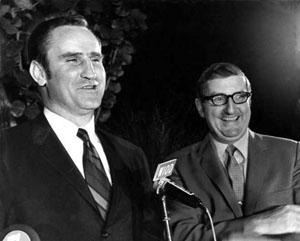
Don Shula and Joe Robbie at the press conference
announcing Shula's hiring by Miami
That's when Rosenbloom came home.
- The rules of the NFL, totally merged with the AFL after the '69 season, required an owner wanting to talk to a coach under contract to get permission from the coach's current owner.
- So Carroll immediately filed tampering charges against Robbie with Commissioner Rozelle. Pete took the Dolphins' No. 1 draft pick for 1970 and gave it to the affronted Colts.
- When Robbie called Rosenbloom, the Colt owner snapped, "I don't want to talk to you about anything," and hung up.
- At the NFL owners meeting in the spring, Shula approached his former boss with a smile and an extended hand. Carroll did an about-face and presented the back of his $300 suit. "It's like this," Rosenbloom explained. "I will not talk to Robbie or Shula ever again. One stole something from me. The other allowed himself to be stolen."
Shula improved the Dolphins immediately. He began, as new coaches always do, by changing the culture of the team.
- The players loved Wilson but for the wrong reasons. He was easy-going, even deciding to call off practice occasionally when the Florida sun was too hot.
- Shula's business-like, no-nonsense approach instilled badly-needed discipline just as Vince Lombardi did when he took over the lackluster Packers in 1959.
- Miami jumped to a 10-4 record in 1970, with one of the defeats a 35-0 shellacking in Baltimore in the "Rosenbloom-Robbie Bowl." The Colts didn't miss Shula at all, winning the AFC championship. New coach Don McCafferty did what the other Don couldn't do by winning the Super Bowl over the Cowboys.
- The Dolphins made the expanded playoffs but, after beating the Cincinnati Bengals (coached by Shula's mentor, Paul Brown) 17-0, lost to the Oakland Raiders 17-14.
1971 saw Miami overtake the Colts atop the AFC East.
- The Dolphins' 10-3-1 record edged Baltimore by a half game.
- Miami opened the playoffs on Christmas with a 27-24 OT victory over Kansas City in the longest game ever.
- They then shut out the defending champion Colts 21-0 in Miami to reach the Super Bowl.
- But once again Shula failed on the biggest stage. The Cowboys dominated, 24-3, in a cold Tulane Stadium.
- Counting the loss to Cleveland in 1964 in the NFL Championship Game, tt was Don's third loss in three tries in his league's championship game.
Nevertheless, his colleagues wanted to understand the keys to Shula's success.
- Other coaches picked the brains of former Colts and Dolphins and were sometimes surprised by what they learned. Noted taskmaster George Allen of the Washington Redskins couldn't believe practices never ran more than one hour 45 minutes. Neither could Oakland coach John Madden: "You can't have that kind of execution practicing that little."
- But that was one of many ways Shula imitated Paul Brown - by being demanding without being brutal, emphasizing mental preparation without overworking his team physically.
So, despite lots of success, Shula entered the 1972 season with the "Can't Win the Big One" albatross hanging around his neck.
1972 Dolphins' season
|
References: "The Rosenbloom- Robbie Bowl," Jack Olsen, Sports Illustrated, November 9, 1970
Still Perfect! TheUntold Story of the 1972 Miami Dolphins, Dave Hyde (2002)
Top of Page
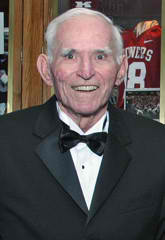 Don Looney late in his life
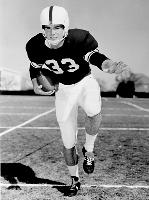
Joe Don Looney at Oklahoma
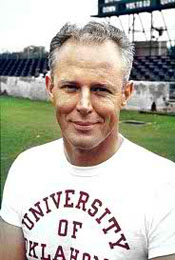
Bud Wilkinson
Top of Page
|
If ever a player was aptly named, it was Joe Don Looney.
A 1995
article in Sports Illustrated called him "the greatest
player who never was."
Joe Don roared out of Fort Worth like the Texas wind.
- After attending Texas, TCU, and Cameron Junior College, he enrolled at Oklahoma where
he exhibited outstanding skills as a RB and punter.
- Unfortunately, he was also
a royal pain in the ass for every coach who took a chance on him except one - as we'll explain.
- To say that Looney had problems with authority is putting
it mildly. Never once in college or the pros did he play two complete
seasons in a row with the same team.
Oklahoma coach Bud Wilkinson should have known what he was getting in Joe Don, who had exhibited anti-social tendencies at an early age.
- Joe Don was the only child of Don Looney, a star E at TCU who played on the Horned Frogs' national championship team in 1938, catching passes from Heisman Trophy winner Davey O'Brien.
- The elder Looney gave a hint late in his life of a family trait that his son inherited when Don jokingly (?) told an interviewer:
Davey is only famous because I caught his passes.
- In a situation similar to one decades later when Todd Marinovich's father sculpted him into a college QB from childhood, Don started out to make his boy "the greatest gridder ever." Small for his age, Joe Don lifted weights from an early age.
- Still, the son felt he needed to establish an identity of his own. So in junior high, he was elected cheerleader! Not what his father had envisioned.
- However, it soon became clear to Joe Don that he had been blessed with extraordinary athletic ability.
Harnessing that talent was another matter.
- In a Pony League game, he heaved his bat when called out on strikes. The club landed in the grandstand, hitting a woman in the head. The umpire ejected the brat from the game.
- He competed in high school football, catching the eye of college coaches his junior year with his size and speed. But he preferred track where he could just run and not have to conform to team rules.
- He continued his odd ways. For example, as a senior, he earned a spot in the 220 finals at the regional meet, then told his coach he was dropping out of the finals. When the coach asked whether he was injured, Looney replied, "I'm just depressed."
- Years later, he told writer Mike Stropshire, his high school classmate, the real story. After the semifinals, Joe Don and a rival runner enjoyed a heavy lunch with a couple of beers. Then the other boy showed him the .45 automatic he kept in his glove compartment.
I just couldn't really get into running that 220 after that.
Deciding that track held the most promise for him, Looney drove his '59 Impala to California where he attended the meets leading to the 1960 Summer Olympics trials.
- He wanted to study the training habits of the most successful tracksters the country had to offer.
- The one who impressed him the deepest was shot-putter Dave Davis. Joe Don recalled:
I had dinner with Dave Davis ... Davis ordered a pitcher of beer, took the thing in one hand, and downed it in a couple of swallows. That was impressive, and from then on, I wanted to be just like Dave Davis.
Joe Don returned to his home state and enrolled at the University of Texas.
- The venerable track coach at UT, Clyde Littlefield, heard Joe Don was in school and arranged for him to practice with the team as a walk-on. Looney later related what happened after his first practice.
Littlefield told me I was one of the best athletes he'd ever seen step on the track at Memorial Stdium. I don't believe he actually meant that, though. Impressed me as being kind of phony.
- So Joe Don never attended another track practice, instead joining his fraternity's intramural football team.
- But Looney didn't last the semester at the frat house. The last straw was his supposedly throwing a guy through the plate-glass window at the Toddle House diner. This was actually one escapade that Joe Don wasn't involved in, but you couldn't blame the heads of the fraternity for believing the story after all the other "adventures" their problem child had been at the center of.
- There was also his - shall we say - indifferent attitude toward school. His math professor returned a test paper with a score of 18 and a handwritten note, "Mr. Looney - are you joking?"
- But his stay in Austin did accomplish one thing - it rekindled his desire to play football.
Looney moved back to Fort Worth and enrolled at TCU for the second semester of the 1960-1 school year.
- He planned to try out for the football team until he learned he'd have to sit out a year as a transfer.
- Still, he dedicated himself to getting in shape for the gridiron. He lifted weights day after day in his room in the basement of his parents' house next to the parking lot at the TCU football stadium. He climbed over the stadium fence and ran the steps alone, hour after hour.
- By night, though, he turned into a pub crawler. When alcohol inhabited his blood stream, Joe Don turned into a raging bull at the slightest provocation. Let's just say that he wore out his welcome at TCU just as he had at Texas.
Don Looney contacted Leroy Montgomery, the football coach at Cameron Junior College in Lawton OK, and asked him to let Joe Don try out.
They came out kind of half black. I mean, I went ahead and wore the dyed pants in the game, but they looked like hell.
One school that wanted Looney was the University of Oklahoma.
- Coach Bud Wilkinson had enjoyed unprecedented success in Norman, his teams forging 31- and 47-game winning streaks. However, the Sooners, after five straight years of double-digit victories, went 7-3 in '59 and a shocking 3-6 in '60 before breaking even, 5-5, in '61.
- Bud should have known to avoid Joe Don like the plague because one of the players who had gashed Wilkinson's tradition of team over individual was Wahoo MacDaniel, almost as big a flake as Looney.
- But hard times, and four straight losses to archrival Texas, made Wilkinson rethink his standards, including his no JUCO players policy.
- He convinced Joe Don to matriculate at Oklahoma for the '62 season. It would be a decision that would hasten Bud's departure from college coaching and that he would regret to his dying day.
Continued below ...
Reference: Runnin' with the Big Dogs: The Long, Twisted History of the Texas-OU Rivalry, Mike Shropshire, 2006
"Looney Is Playing a New Tune," Jack Murphy, Sports Illustrated, August 4, 1969
|
The
6'1" 230 lb. Looney had a productive season in 1962 for Bud Wilkinson's Big Eight champions. He began his career in Norman with a bang.
- The Sooners trailed Syracuse 3-0 in the opener at Owen Field when Looney finally took the field with 2:10 to play.
- When Joe Don entered the huddle, the QB asked him what play the coaches wanted run. "Just gimme the ball," answered Looney.
- That's what the signal caller did, and the highly-touted RB burst 65y to win the game 7-3. If Wilkinson had sold his soul to the devil, at least he got some benefit from the pact.
- Looney led the Sooners in rushing in the Texas game and rocketed a 60y punt, but the Longhorns won 9-6.
- OU never lost again in the regular season, taking the Big Eight crown and playing in the Orange Bowl, their first post-season action in four years.
- Joe Don finished the season fifth in the country in rushing, averaging 6.2 yards per carry, and first in punting with a 43.4 average.
- However, he lasted only three games
the next season before Wilkinson kicked him off the
team for slugging a graduate-assistant coach.
- Oklahoma story #1: Joe Don arrived at 7 pm at the sorority house to pick up his date who was considered the most gorgeous girl on campus. When she didn't come downstairs by 7:02, he left a note: "Joe Don waits for no one."
- Oklahoma story #2: A reporter in the locker room after a game noticed that Looney tossed his dirty shirt into the bin labeled "Socks." When the scribe asked him why he did that, the Looney-bin one replied:
No goddamn sign is going to tell me what to do.
- Years later, Joe Don would reflect on his OU days.
I don't think Wilkinson ever liked me very much. I could have gained more than 1,000 yards, I could have done anything, but they wouldn't give me the ball. I guess Wilkinson had his reasons, but I was mystified by his attitude.
He was the greatest athlete and craziest sociopath I ever coached.
Enthralled
by his potential, the New York Giants selected Looney in the first round of the 1964 NFL Draft. His stint with the team lasted 28 days.
- Giants story #1: Coach Allie Sherman ordered Looney to tape his ankles. Joe Don refused. "I know
more about my ankles than you do."
- Giants story #2: One night Looney was 10 minutes late for bed check. He deemed the $50 fine unfair because he had gone to bed an hour early the night before. He explained: They still owe me 50 minutes.
The Giants traded to the Baltimore Colts just before the season started.
I don't like big cities, and I didn't care for Allie Sherman's attitude. The Giants really weren't very friendly. It was as though it was undignified to wear shorts in the dorm. You were expected to wear slacks.
- Baltimore Coach Don Shula: "I
wanted him. He had all this fantastic natural ability."
- Joe Don respected Shula because "he knew what he was doing." But he carried the ball just 23 times for the Colts.
- Colts story: When Joe Don arrived 15 minutes late for a
meeting, Shula fined him $100. Looney asked:
OK, but how
come you didn't give me $100 for being 15 minutes early last
night?
After
the 1964 season, the Colts traded Looney to the Detroit Lions. He had a fairly good season: 114 carries for
356y and five touchdowns.
- Lions story: During a game, coach Harry Gilmer turned to Joe Don and gave him a play to take in to the QB.
His reply earned him a suspension.
If you want a messenger, call Western Union.
On
to Washington where coach Otto Graham thought he could handle Looney when no one else could: 55 carries for 178y.
- Redskins story: During a half-speed workout, Looney suddenly
lowered his shoulder and belted All-Pro LB Sam Huff. Joe Don stood over Sam and yelled,
"How did you like that, big boy?" Huff got his revenge on the next play.
After
a stint in the Army in Vietnam, Looney joined the Saints in 1969.
- His contribution:
3 carries for -3 yards.
- He
did football coaches everywhere a favor by retiring after that season.
- He also did himself a favor because he had played football only because
people told him he was good at it and it attracted women.
After
retirement, Looney converted to Hinduism and became
an "enforcer" for a Swami.
- Joe
Don died in 1988 when his motorcycle missed a curve on a Texas
highway. Many would consider his death fitting since he never negotiated
life's curves.
- Amazingly, he was wearing a safety helmet when his body
was found after the accident – perhaps the only time in his life
he conformed to society's regulations.
|
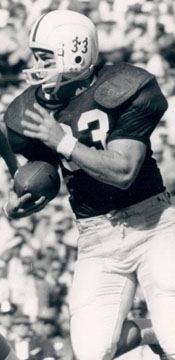
Joe Don Looney at Oklahoma
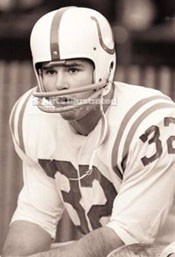
Looney with Colts
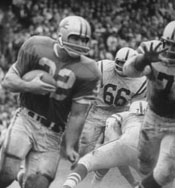
Looney with Lions
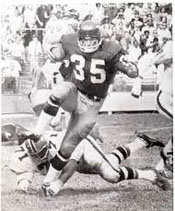
Looney with Redskins
Top of Page
|
Charlie Justice created a sensation in North Carolina even while in high school.
- Justice graduated in 1943 from Asheville High School after leading his team to undefeated seasons his last two years, outscoring the opposition 487-7. The '42 team scored a point a minute against mostly out-ofstate opponents.
- He averaged an unbelievable 25 yards per carry his senior year.
- Charlie made All-State and All-Southern both years and led the South with 172 points.
- Justice scored three touchdowns for the North Carolina All Stars against their counterparts from South Carolina in the 1942 Shrine Bowl.
With World War II raging, Charlie had to serve in the military instead of accepting one of the 12 scholarship offers to play college football.
- He reported to the Bainbridge Naval Training Center in Maryland in the summer of 1943.
- The base fielded a football team composed mostly of college guys and even a few NFL veterans.
Justice joined 98 others in trying out for the team but didn't immediately impress Coach Joe Maniaci.
- Joe had played for Fordham University as well as the Brooklyn Dodgers and Chicago Bears of the NFL.
- Seeing the 5'10" 165 lb boy fresh out of high school, Maniaci told Charlie to stay out of the way and just field punts. "You won't get hurt that way, kid."
- As the story goes, Charlie didn't even have a pair of cleats as he went to the other end of the field. Not content with just shagging punts, Charlie booted the ball 65y back up the field while wearing sneakers.
- "Who kicked that ball?" yelled Maniaci. When Justice was identified as the perpetrator, Joe asked him, "You kick like that all the time?" "I do it better when I'm wearing football shoes," shot back Charlie.
- Over time, Justice got a chance to show what he could do with the ball in his hands. After two weeks, he got cleats and made the team.
- Maniaci put him in during the sailors' scrimmage with the nearby Washington Redskins. Justice intercepted two passes, made four tackles, averaged 5y per carry, and ran 46y for Bainbridge's only touchdown. Little did Charlie know that he would later play for the Redskins.
- Observers couldn't believe that Charlie had played only high school football. The pros on the Fighting Commodores team liked his competitiveness and even temperament and took him under their wing. This allowed Justice to gain their respect in the huddle as he called plays.
- Maniaci became a big fan. "He's got everything. He can run, tackle, block, and boot that ball a country mile."
Bainbridge began their schedule against other service teams.
- To utilize the talent he inherited, Maniaci employed three backfields, including several All-Americans like Bill deCorrevont of Northwestern and Bill Dutton of Pittsburgh.
- Justice never started but had an impact on almost every game.
- Bainbridge 26, Curtis Bay Coast Guard 7: Charlie scored the final touchdown on a 32y INT return.
- Bainbridge 49, Camp Lee 9: Charlie took a lateral from deCorrevont and raced 60y to paydirt. Justice also added a touchdown in Q4.
- Bainbridge 54, Curtis Bay 0: In the last period, Justice caught a 72y touchdown pass, "bobbing and dancing his way the last 45y."
- Despite missing several games with a bad back, Charlie earned the "MidAtlantic Rookie of the Year" award from the Associated Press. "Justice seems to be the surprise package of '43. You'll hear more from him."
- The Fighting Commodores finished the season 7-0. For the first time, the AP poll included service teams, with Bainbridge finishing #17. They were that low because they didn't play any college team, V-12 or otherwise.
Justice stayed at Bainbridge as a physical education instructor for 1944 and played an even bigger role in the football team's success.
- In the 43-0 victory over Camp Lee, Charlie picked up where he left off in 1943, scoring two 50y touchdowns, one on an INT and the other on a punt return. In neither case did an opponent lay a hand on him.
- Camp Lejeune fell 53-7 as Justice handled the ball seven times and scored on runs of 83, 51, 50, and 32y. The three non-scoring carries netted 34, 26, and 12y. On the 83y touchdown, he took a lateral and started for the western sidelines, then reversed field, and side-stepped a half dozen enemy tacklers to the end zone.
- The Camden (NJ) Blue Devils were an undefeated team in the eastern professional football league when Bainbridge tromped them 47-7. "Youthful Charley Justice again stole the show offensively." He scored on a 3y end sweep and a 36y gallop off tackle. He also booted three extra points but each was nullified by a penalty. (You didn't get to retry the PAT after an offensive penalty in those days.)
- "The greatest natural football player I've ever seen," to quote Coach Maniaci, contributed to the 15-7 victory over Maxwell Field at Montgomery AL. Justice took a lateral and galloped around RE from the 6 to score. His passes, including a 35 yarder, sparked the drive. He broke a 7-7 tie in Q2 by running 17y for a touchdown.
- Against North Carolina Pre-Flight at Kenan Stadium in Chapel Hall, Justice's home field after the war, Charlie scored on a 42y screen pass in the 49-20 trimph. He also put 6 on the board on a 65y naked reverse. ("Naked" meant he had no blockers after he took the second handoff or lateral.)
- In a rematch with Camp Lejeune, Justice made a dazzling 83y run, faking out the last defender, former Wisconsin All-American Elroy "Crazy Legs" Hirsch. "The kid" handled the ball seven times from scrimmage for 145y and 3 touchdowns.
- Justice earned a position on the AP All-Service second team and made first string on the Mid-Atlantic All-Service team.
- 9-0 Bainbridge moved up to fifth in the AP's final 1944 poll.
It was while playing for Bainbridge that Charlie got his famous nickname.
- As the story goes, a naval officer in the stands at one of the games said, "That Justice kid runs like a runaway train. We ought to call him Choo Choo."
- It so happened that the man sitting with the officer was Paul Menton, the sports editor of the Baltimore Evening Sun. He used the monicker, and it spread throughout the nation. Coincidentally, Justice's father worked for a railroad.
Germany surrendered in early May, 1945, allowing the U.S. to concentrate on defeating Japan.
- Justice joined scores of other Navy personnel who were transferred to Hawaii to prepare for the impending invasion of Japan.
- However, the athletes found time - or time was found for them - to play some football on all-star teams in the Honolulu area against similar teams from the Marines and Army Air Corps.
- The games drew crowds of 45-50,000. Justice's team finished 2-2.
- After Japan surrendered in early September, Justice played his final game as a serviceman for the Pacific All Stars against the Marines in San Francisco.
Hundreds of colleges coveted Justice's services as he returned to civilian life.
Continued below ...
Reference: Football! Navy! War! Wilbur D. Jones, Jr. (2009)
"A Long Locomotive for Choo Choo," Ron Fimrite, Sports Illustrated, October 15, 1973
Top of Page |
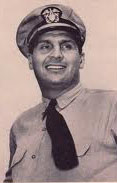
Joe Maniaci

Charlie Justice

Justice running for Bainbridge
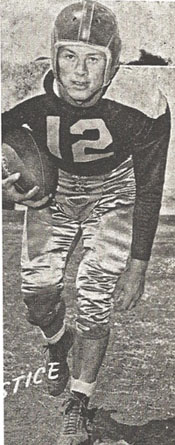
Justice, Pacific All-Stars
|
|
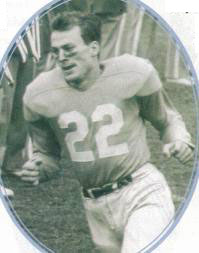
Charlie Justice, North Carolina
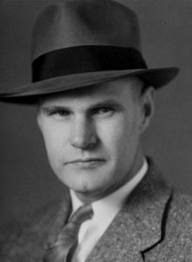
Coach Carl Snavely
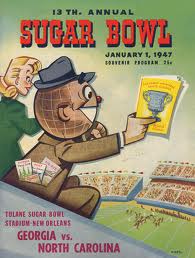
|
When electrifying RB Charlie Justice left the Navy, he got offers not only from countless colleges but also pro teams.
- Called the hottest property in football history at that time, Charlie spurned the advances of the NFL's Philadelphia Eagles, Chicago Bears, Boston Yanks, and Washington Redskins.
- One coach said of Charlie, "Calling him a freshman football player when he enters college is like calling Joe Louis a promising young fighter."
- At one point during Justice's Navy service, Duke Coach Eddie Cameron thought he had the inside track on landing North Carolina's favorite son. Charlie also seriously considered South Carolina.
- Instead, he accepted an offer from North Carolina on one condition. Since he could fund his education via the G.I. Bill, he wanted the university to give his scholarship to his wife Sarah. After attending classes for two years, she dropped out when their daughter was born.
- Justice was a legend before he ever set foot on the Chapel Hill campus, thanks to his high school exploits in Asheville and the sensational reports of his play in the Navy.
Second-year Coach Carl Snavely ran the single wing O even as many schools turned to the T formation following World War II.
- Justice epitomized the "Triple Threat Tailback." He could run, pass, and punt with equal ease. He also excelled as a kick returner.
- His four years at UNC produced a 32-7-2 record, the greatest era in school history.
Here's the year-by-year breakdown.
1946
- In February, the first post-war winter drills concluded with a scrimmage against Guilford College. 1,000 Carolina students attended to get their first glimpse of the superstar. Snavely didn't start Justice but, when he finally put him in, called his number on the first play.
Charlie swung wide to his right, cantering, searching for an opening. Then he cut back with astonishing swiftness against the grain of tacklers and was suddenly in the secondary. Everything - head, shoulders, legs - seemed to move at once, and in different directions. Free now of the safetyman, he was running alone down the sidelines, his head thrown back triumphantly as he approached the goal line. There was a shocked silence at first. Then the cheering began. (Ron Fimrite)
- Charlie led the Tar Heels to their first victory over archrival Duke in six years, 22-7. The triumph secured UNC's first Southern Conference championship since 1925.
- The 8-1-1 season ended with North Carolina ranked 9th in the final AP poll and headed to their first ever bowl appearance, a 20-10 loss to Georgia and its All-American, Charlie Trippi, in the Sugar Bowl.
- Justice made Honorable Mention on the All-American team. (You might think he would rank higher since he was 22 years old but remember that many other ex-GI players were as old or older.)
1947
- The Tar Heels beat Tennessee, 20-6, to avenge the only regular season defeat the previous season.
- For the second straight year, the Tar Heels ranked ninth in the final AP poll. However, their 8-2 record wasn't enough to get them an invitation to one of the five bowls played in that era.
- Charlie made the Associated Press All-America second team.
|
|
|
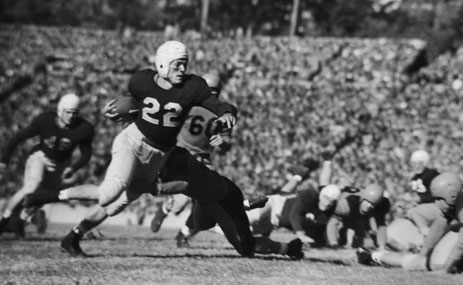
Justice in action for UNC 1948
- Justice started fast with sensational games against Texas and Georgia. Against the Longhorns, he ran for two touchdowns and passed for two more in the 34-7 victory. The next week in Athens, he scored three times, including an 84y punt return, as the Tar Heels won 21-14. Justice gained a total of 304y in the contest.
- The only blemish on the season was a 7-7 tie against William & Mary.
- In the finale against Duke, he broke open a 0-0 game in Q3 with a 43y run that went from sideline to sideline and covered about 100y.
Coach Snavely, normally an impassive man, rushed from the bench to grab Charlie by both shoulders and shake him. "Great!" he kept shouting. "Great!"
- Charlie was a consensus first team All-American and finished second in the Heisman Trophy voting to SMU's Doak Walker.
- The #3 Tar Heels again went to the Sugar Bowl but lost to #5 Oklahoma 14-6.
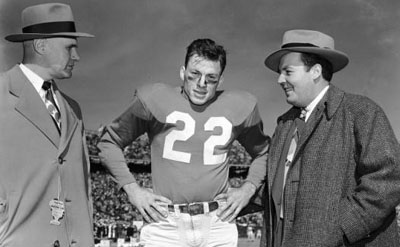
Coach Snavely, Justice, and broadcaster Harry Wismer before 1949 Sugar Bowl
1949
- The hype reached a crescendo for Charlie's senior season.
- Orville Campbell, a Chapel Hill music publisher, and Hank Beebe, a graduate student in music, produced a song about Charlie, All the Way Choo Choo. The Johnny Long Orchestra recorded it, and the Benny Goodman Orchestra played it on the radio.
- Justice made the cover of Life magazine, considered the #1 media accomplishment in that pre-TV era.
- On October 22, UNC visited LSU, whom they had thumped 34-7 the previous season. After the sprinklers were "inadvertently" left on overnight, the Tigers held Justice in check to take a 13-7 victory.
- The Heels defeated archrival Duke 21-20 to complete a sweep during Charlie's four years.
- UNC won the Southern Conference crown with a perfect 5-0 league record. The last AP poll listed the 7-3 Tar Heels at #16.
- Justice again earned the runner-up spot in the Heisman voting behind E Leon Hart of Notre Dame. Charlie thus ranks as one of only three players to finish second twice - Glenn Davis of Army (1944-5) and Darren McFadden of Arkansas (2006-7).
- The campaign ended with a 27-13 loss to Rice in the Cotton Bowl to thwart Charlie's hopes of winning a bowl game during his sensational career.
|
|
|
Justice established a score of records at UNC.
- He scored 234 points, running for 39 touchdowns and passing for 26 more.
- He accumulated 2,634y rushing. His total offense mark of 4,883y lasted for 45 years. When QB Jason Stanicek broke it in 1994, Justice was on hand to graciously congratulate him.
- Needless to say, Charlie's number 22 has long been retired at Carolina.
- Later in his life, Justice said:
I loved Carolina, the people here, and I loved football. It was right after the war and folks had been penned up so long, they just had to let go. But everybody was respectful of one another here. It was a good time. I suppose I could have been a lot of things ... but I was a football player, and that's all I ever wanted to be. I didn't even mind practice. Heck, I would've stayed out there all night if they'd let me.
Justice played in the annual College All-Star game at Soldier Field, Chicago in August 1950.
- Playing with the last of the "war babies" like himself who played in college after serving in the military, he won the MVP award as the All-Stars defeated the NFL champion Philadelphia Eagles, 17-7.
- Charlie gained 133y, which was 48 more than the Eagles amassed as a team. He set up a touchdown with a 60y pass reception from Eddie LeBaron.
Charlie played four seasons for the Washington Redskins.
- Because of his size, he wasn't drafted until the 16th round (201st overall).
- Hampered by injuries, he gained 1284y rushing (4.8 average) and another 962 on receptions. He scored 10 touchdowns. He averaged 40.4 on 94 punts.
- His 1050y from scrimmage was fourth in the NFL in 1953.
Liked by everyone who ever met him, Justice made frequent appearances at his alma mater until his death in 2003 at age 79.
- The following year, the university unveiled a statue of its greatest football player outside Kenan Stadium.
- The memorial was commissioned by a number of Charlie's teammates.
|
|
The Green Bay Packers made FB Jimmy Taylor their second round draft pick in 1958. Taylor was an All-American his senior year at LSU and earned the MVP award at the Senior Bowl.
- The Pack had not had a winning record since 1947, and even then it was only 6-5.
- Since legendary coach Curly Lambeau retired after the 1949 season, GB had gone through four head coaches, including three in one season (1953 when the record was 2-9-1).
- Taylor arrived in Wisconsin with new coach Ray "Scooter" McLean, who replaced Lisle Blackbourn, whose four-year record was 17-41.
- As an example of his ineptitude, Blackbourn asked Bart Starr to leave with him and become his QB coach at Marquette University. Lisle told Bart he would have a "tough time" making it as a pro QB. Fortunately, Starr declined the offer.
- As an example of the ineptitude of the man who took Blackbourn's place, Taylor sat on the bench for the first 10 games of the '58 season. As Taylor explains, "McLean had a reputation as a good assistant coach, but as a head coach he was in over his head."
- One of the problems McLean inherited was Paul Hornung. In the light of the career that Hornung fashioned, that's a strange statement. But the Heisman Trophy winner from Notre Dame, who joined the team for the '57 season, didn't seem a good fit at any backfield position. A triple threat QB in college, Paul wasn't fast enough to play HB in the NFL and didn't have a strong enough arm for QB. So McLean played him at FB.
Taylor found the training and practices less demanding than Paul Dietzel's college regimen. Taylor recalls:
- Poor physical-conditioning training and lackluster practices were the norm. One day while at practice, McLean called for wind sprints. After running a few laps, our veteran receiver Billy Howton yelled out, 'Come on, Scooter, we need to save our legs for Sunday!' With that, Scooter smiled, blew his whistle and ended practice.
- Instead of utilizing film reviews as a teaching tool, the coaching staff basically just ran the film. The film sessions were useless.
The result was predictable. The 1-10-1 record was the worst in franchise history. And one game epitomized everything that was wrong.
- On November 2, 1958, the Packers visited their Western Division rival, the Baltimore Colts. (No, you haven't forgotten your geography. Despite being an East coast city, Baltimore played in the Western Division because the Dallas Texans franchise transferred to Baltimore after one disastrous year in Texas.)
- The Colts verged on greatness with a backfield of Johnny Unitas, Lenny Moore, and Alan Ameche, Raymond Berry at WR, and a D-line led by Gino Marchetti and Art Donovan.
- The Packers fumbled the ball on the opening kickoff, and the Colts quickly scored. The same thing happened on the second kickoff. The next possession, the Packers at least waited a few plays before turning it over. 21-0 Colts.
- Unitas had the Colts deep in Packer territory again when he ran out of the pocket up the middle. CB John Symank (who would later coach at LSU) knocked John down and kneed him in the ribs. Backup QB George Shaw took over and made it 28-0 at the half.
- Infuriated by their leader's injury, Baltimore poured it on to the tune of 56-0.
- The next day, Art Daley published his report on the game for the Green Bay Press-Gazette: The second half of the game was an almost complete lack of effort and their performance was the biggest quit in Packer history.
The next week, Taylor finally got a chance to play some offense against the Bears in Chicago after participating only on special teams.
- Green Bay lost 24-10, but Taylor scored the only touchdown, the team's first in eight quarters.
- After two more losses, Jimmy finally got a chance to start against the 49ers in San Francisco. He gained over 100y in the 48-21 loss.
- In the finale against the Rams in the Los Angeles Coliseum, Taylor ran for 106y on 22 carries. LA won 34-20. That gave him 247y for the season, almost all in the last two contests.
McLean resigned before the Board of Directors could fire him.
- Team administrator Jack Vainisi consulted NFL commissioner Bert Bell and Cleveland Browns coach Paul Brown concerning a replacement.
- Both recommended the same man, the offensive coach for the New York Giants.
- When the Packers announced their choice, one of the members of the Green Bay committee asked, "Who the hell is Vince Lombardi?"
It wouldn't take long for Green Bay rooters and football fans everywhere to learn who Lombardi was - a winner.
To be continued ...
Reference: The Fire Within, Jim Taylor with Kristin Setting Clark
Top of Page |

Jimmy Taylor
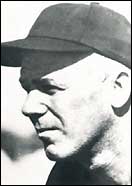
Ray "Scooter" McLean
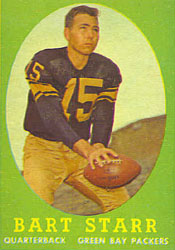
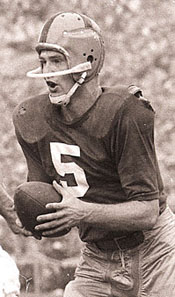
Paul Hornung at Notre Dame
|

Vince Lombardi

Jim Ringo
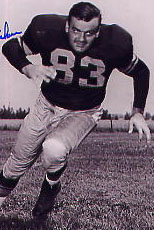
Bill Quinlan
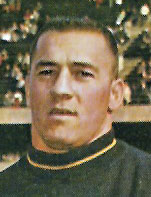
Jim Taylor
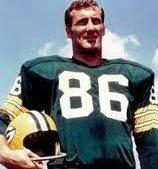
Boyd Dowler

Randy Duncan
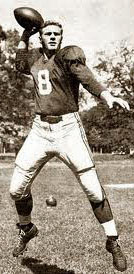
LaMar McHan

Paul Hornung follows Fuzzy Thurston on the Green Bay Sweep

Jerry Kramer

Bart Starr
|
Vince Lombardi took over a Green Bay franchise in 1959 that had fallen and couldn't get up - a shadow of the mighty team that had won six NFL championships from 1929-1944.
- The former New York Giants assistant also took charge of trades and contract negotiations.
- A stickler for details, he even had the team uniform revamped to what is still worn today.
- Prior to the start of training camp, All-Pro C Jim Ringo asked to be traded because he couldn't face another year of losing. He would be thankful that Lombardi didn't accede to his request.
- On the other hand, Cleveland DE Bill Quinlan threatened to quit when he learned he had been traded, along with DT Henry Jordan, to the Packers. But Lombardi stroked Quinlan's ego by explaining that he needed a player of his caliber to help turn around his new team.
Second-year FB Jimmy Taylor learned that Lombardi knew what he was doing even before the season began.
- Vince sent assistant Red Cochran to spend a month with Jimmy in Baton Rouge to teach him Lombardi's offense that had propelled the Giants to the championship game twice in the previous three years.
- Taylor also found out that the new coach was a tough negotiator. Jimmy's contract called for a $1,000 bonus on top of the base salary of $9,500. But he would have to earn every penny of the bonus by his performance on the field.
- Jimmy had carried only 52 times in 1958 but would more than double that number under the new regime.
On the eve of the start of training camp in July, Lombardi gave his first talk to the entire team. Almost every player present that day can quote parts of it.
- Gentlemen, I have never been associated with a losing team, and I don't intend to start now. We are going to win some games. Do you know why? Because you are going to have confidence in me and my system. By being alert, you are going to make fewer mistakes than your opponents. By working harder, you are going to outexecute, outblock, and out-tackle every team that comes your way. ...
- There is nobody big enough to think that he has got the team made or can do what he wants. Trains and planes are going in and coming out of Green Bay every day, and he'll be on one of them. I won't. I'm going to find 36 men who have the pride to make any sacrifice to win. There are such men. If they're not here, I'll get them. If you are not one, if you don't want to play, then you might as well leave right now. ...
- In a small town, you need definite rules and regulations, and anybody who breaks these will be taken care of in my own way. You may not be a tackle, you may not be a guard, you may not be a back, but you will be a professional!
- Lombardi admitted later on that he was nervous as hell before giving that speech and worried that many players would leave before the first practice the next day. But not one of them did.
Taylor soon found out that Lombardi meant what he said about enforcing definite rules.
One night Vince came into my room. I was sitting on the edge of my bed with my socks and shorts on. The time was 11:00 PM.
"Jimmy, what time do you have?" asked Vince.
"I've got 11:00, sir," I answered.
"Jimmy, you're supposed to be in bed at 11:00, aren't you?"
"Yes, sir," I replied.
"Jimmy, that is going to cost you $25!"
I never made that mistake again!
Vince also made personnel changes that improved the team.
- Paul Hornung had won the Heisman Trophy as a QB at Notre Dame. But he spent his first two years with Green Bay as a FB. Lombardi installed him at LH next to Taylor.
- He drafted Colorado QB Boyd Dowler and moved him to flanker.
- Not satisfied with the QBs he inherited, Babe Parilli and Bart Starr, Lombardi used the #1 pick in the draft to take Randy Duncan, who had led Iowa to the Big Ten championship and a Rose Bowl victory. But, not wanting to play for a team that had won only one game in '58, Randy signed a contract with the British Columbia Lions of the Canadian Football League.
- So Lombardi acquired Lamar McHan from the Chicago Cardinals on a conditional basis. If McHan made the team, the Packers would give the Cardinals their third round pick in the next draft. Vince had been impressed with McHan's strong arm and toughness when the Giants played the Cards twice a year. What he didn't know or overlooked was that Lamar was temperamental and sulked when criticized.
Lombardi's practices were shorter than those of the previous season but much more intense and focused, with little wasted effort.
- He had the players run laps the first day. When he noticed two guys running lackadaisically, he yelled, If you fellows don't want to give me 100 percent, get on up to the clubhouse and turn in your equipment.
- Lombardi pounced on every miscue. Drop a catchable pass and run a lap.
To eliminate mistakes, Vince simplified the offense to ten runs and eight passes. His most famous play became known as the "Green Bay Sweep."
- The QB handed off to either Hornung or Taylor with the back without the ball leading the runner around E behind pulling Gs Jerry Kramer and Fuzzy Thurston.
- As Taylor says, Like many of Lombardi's plays, the sweep relied on a minimum of deception but a maximum effort.
- It was the first play he installed, telling the offense, Gentlemen, if we can make this play work, we can run the football.
- He began and ended every practice with the power sweep until the players could run it in their sleep.
The new system paid dividends right away.
- After gaining confidence by winning four of six exhibition games, the Packers began the regular season by upsetting the Bears, whose longtime coach, George Halas, was Lombardi's idol. Their improved conditioning helped Green Bay score 9 points in Q4 to overcome a 6-0 deficit.
- Taylor scored the winning touchdown. Sloshing through the mud, I followed pulling guards Thurston and Kramer on a sweep left from five yards out to give us a 7-6 lead.
- When the final gun sounded, the Packers jubilantly carried Lombardi off the field on their shoulders. Arriving at the locker room, Vince proclaimed, We're on our way now!
- The momentum continued with upsets of the Lions and 49ers the next two weeks.
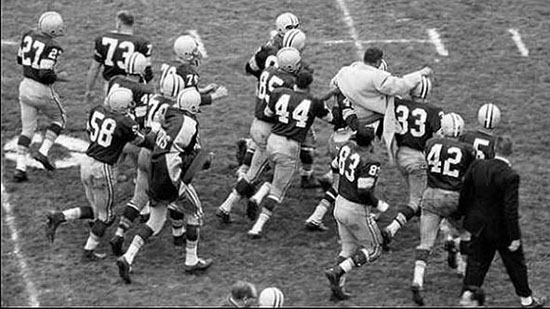
The Packers carry Vince Lombardi off the field after a win in his first game.
But enthusiasm can take you only so far.
- The Los Angeles Rams came to Milwaukee and clobbered the Packers 45-6 in Week Four to start a five-game losing streak.
- When McHan was injured during the fourth loss, Bart Starr took over and played well although the Bears prevailed 28-17.
- With Lamar still unable to perform, Vince started Bart the next week against the Colts in Baltimore. Starr found the confidence he had lacked when he rallied the Packers from a 21-3 halftime hole to lose by only four, 28-24.
- Lombardi's intuition told him that Bart had finally come into his own. You are going to be our QB from here on out. I want you to relax, be calm, and continue studying like you are doing.
- With Starr under C and McHan pouting on the sidelines, the Pack won their last four games, including a revenge 38-20 triumph in the Los Angeles Coliseum.
- The 7-5 record was Green Bay's first over .500 since 1947 (6-5-1). When the Packers returned from the final game in San Francisco, 7,500 fans stood in freezing rain to greet the plane.
- Taylor missed three games because of injury but still compiled these stats: 452y on 120 attempts (3.8 average), 9 receptions for 71y, and 8 touchdowns (six running, two receiving).
Lombardi's system was vindicated.
- The sportswriters voted him Coach of the Year.
- New York owner Wellington Mara asked Vince to return to New York as head coach. But Packers management gave him a $10,000 bonus to keep him in Green Bay.
Continued below ...
Reference: The Fire Within, Jim Taylor with Kristin Setting Clark
Top of Page |
When the 1960 Green Bay Packers training camp opened - the second under Vince Lombardi - Jim Taylor recalls, I saw more veterans arrive early than I could remember, and they were in better physical condition. They all knew what to expect and came prepared.
- Taylor hadn't started any games as a rookie in '58 under the previous regime and started only seven of the nine he played in '59 because of injuries.
- So at age 25, Jim hoped to have a healthy season that would allow him to play in all 12 games of the regular season.
Even though Bart Starr had gone 4-1 in the five games he started in 1959, Vince still questioned his leadership and effectiveness.
- Nevertheless, Starr started the annual opener with the Bears in Green Bay. Taylor scored on a 1y run, but the visitors scored all their points in Q4 to win 17-14.
- Vince put Lamar McHan under C for the second game against the Lions. But when he was ineffective, Starr took over and directed the team to a 28-9 victory with Jimmy again tallying a touchdown.
- Game 3 saw a repeat of Game 2. Lombardi started McHan but pulled him early for Bart, who sparked the 35-21 triumph over the defending champion Baltimore Colts and their legendary QB Johnny Unitas. Taylor rushed for three touchdowns (12, 3, and 1y).
- McHan started again the next week and led a 41-14 rout of San Francisco.
- But when the offense struggled in the first half the following week against the lowly Steelers, Lombardi inserted Starr after the intermission, and GB pulled out a 19-13 victory.
- On the flight home, McHan was very upset about being pulled from the game. When the team stopped at a restaurant, Lamar stormed into the private room where Lombardi was dining and vented his anger, using the word dago at least once.
- The following morning, Vince called Starr into his office and told him, You're my quarterback, and I'm not changing again. In the off-season, McHan was traded to the Cardinals.
- The final piece of the Packers' championship puzzle had fallen into place.
At a press conference during the week, Lombardi used the term Thunder and Lightning to refer to his backfield duo with Taylor being Thunder and Hornung, Lightning.
- Vince: Taylor and Hornung are about results, nothing more. Other backfields around the league may be bigger and faster, but none produce like Thunder and Lightning. Taylor loves contact so much that if no defensive back is in his way, he will go and find one. To watch Hornung running at midfield may be nothing special, but near the goal line he is the best.
- Taylor would rush for 1,101y that season and gain another 121 receiving. Hornung would add 671 on the ground, 257 receiving, and throw HB passes for 118 more - that's over 1,000y (by 46) for him as well. Each blocked for the other crisply.
- Both players would make the Pro Bowl.
But after Lombardi's praise, the Packers suffered through a rough stretch.
- They lost three of four. After the fourth loss, in the annual Thanksgiving game at Detroit, Vince dejectedly informed the media, With a 5-4 record, I guess you'd have to say we're out of it. But he decided to use some reverse psychology on his team. He let them drink liquor on the flight home from Detroit, spoke of how they could turn the remainder of the season into a positive, and took the players and their families out to a Thanksgiving dinner at the Elks Club when they arrived in Green Bay.
- Whether those perks did the trick or not, Green Bay beat the Bears, 49ers, and Rams, all on the road, to take the Western Division by one game over San Francisco.
That put them into the championship game against the 10-2 Philadelphia Eagles, kings of the East.
- The Eagles won a hard-fought contest at Franklin Field 17-13. The game famously ended with MLB Chuck Bednarik tackling Taylor in the open field on the Eagle 10, then holding him down while the last seconds ticked off. When the gun sounded, Chuck stood over Jimmy and said, You can get up. This goddamn game is over! [Some accounts use a different word than "goddamn."] As Taylor and Hornung walked off the field, Bednarik embraced them and told them they would be back in the championship game the next year.
- Afterwards, Lombardi conveyed the same message: I am very proud of all of you, and you have all played well enough to win this game ... I'm sure there is no doubt in your minds now, and that's why you will win it all next year. This will never happen again. You will never lose another championship!

Chuck Bednarik consoles Hornung and Taylor after 1960 Championship Game The Packers fulfilled his promise. Here's how Lombardi's remaining seasons in Green Bay went.
Green Bay Packers 1961-67
| Year |
Record |
Result |
Jimmy Taylor |
| Yds Rushing |
touchdowns |
Honors |
| 1961 |
11-3 |
NFL Champions |
1,307 |
15* |
Pro Bowl |
| 1962 |
13-1 |
NFL Champions |
1,474* |
19* |
MVP (AP, NEA);
Pro Bowl |
| 1963 |
11-2-1 |
Hornung suspended for season |
1,018 |
9 |
Pro Bowl |
| 1964 |
8-5-1 |
|
1,169 |
12 |
Pro Bowl |
| 1965 |
10-3-1 |
NFL Champions |
734 |
4 |
|
| 1966 |
12-2 |
NFL and Super Bowl Champions |
705 |
4 |
|
| 1967 |
9-4-1 |
NFL and Super Bowl Champions |
390 |
2 |
With Saints |
| |
|
|
* = led league |
As the table shows, Taylor's production declined sharply after five straight 1,000+ seasons (including 1960).
- His running style inflicted pain on defenders but also caused wear and tear on himself.
- Lombardi, knowing that Jimmy was fading, offered him only a one-year contract after the '65 season.
- So as a free agent after the '66 campaign, Taylor signed with the New Orleans Saints for their maiden season in '67. Lombardi left Hornung off his protected list of players the Saints could not take in the expansion draft. So Thunder and Lightning ended up teammates again.
- But the pairing didn't even make it to the beginning of the season. After a doctor told Paul that x-rays showed that a hit could turn him into a paraplegic, the Golden Boy retired.
- Jim gave it one more go for the excited fans in his home state but threw in the towel after the '67 season.
Jimmy Taylor was elected to the Pro Football Hall of Fame in 1976 after being a finalist the previous three years.
|
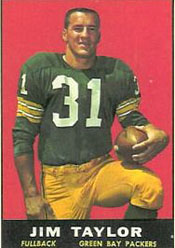
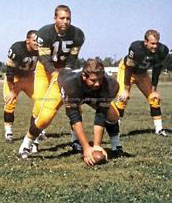
Bart Starr under C Jim Ringo
with Taylor and Hornung
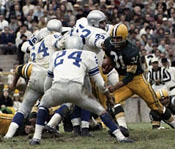
Taylor runs against Lions 1960
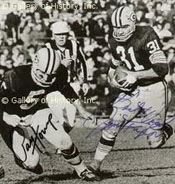
Hornung blocks for Taylor
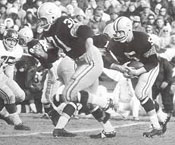
Taylor blocks for Hornung

1966 Sports Illustrated cover
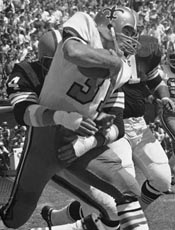
Taylor runs for Saints
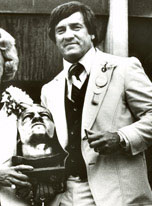
Taylor at his HOF Induction
|
Jesse Harper, the Man Who Put Notre Dame on the Football Map - I
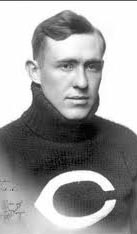
Jesse Harper at
University of Chicago

Amos Alonzo Stagg
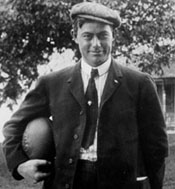
Fielding Yost
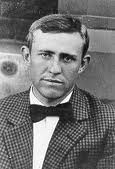
Jesse Harper at Notre Dame
|
Even the average football fan knows that Knute Rockne was a great coach at Notre Dame. But few know Rockne's coach who made the Fighting Irish nationally known on the gridiron and built the foundation on which Knute built.
- Jesse Harper (first name pronounced "Jess") played college ball for the famous Amos Alonzo Stagg at the University of Chicago from 1902-5, although Jesse's favorite and best sport was baseball. On the gridiron, he backed up the famous QB Walter Eckersall.
- Harper was influenced not only by Stagg's understanding of the tactics and techniques of football but also by his mentor's ability to develop strong character in his players.
Upon graduation, Harper began his coaching career.
- He went to Alma College, a small Presbyterian school in Michigan. As was typical at that time, he coached all the sports: football, which he inaugurated, baseball, basketball, and track and also managed the entire athletic program.
- Amazingly, Harper's team crafted a 2-2-2 record in their maiden season.
- He started a habit that he would follow throughout his coaching career: scheduling challenging teams. His final game at Alma crowned his tenure there: a 0-0 tie with Michigan Agricultural College (Michigan State today).
His next post (1909-12) was Wabash College in Indiana. He again was praised for developing a "green" team his first year.
- Faced with bigger, more experienced opponents, Harper turned to the new weapon that had been unleashed by the rules changes of 1906: the forward pass. He had his boys use the tactic frequently in their 18-17 upset of Purdue. The following week, the Little Giants fought hard but succumbed at Notre Dame 38-0.
- Harper capitalized on additional rules changes in 1910 that removed almost all the restrictions on forward passing (such as no pass could be thrown or caught more than 5y to the right or left of the centering point) to lead Wabash to four victories to start the year: Georgetown 57-0, Purdue 3-0, Butler 4-0, and St. Louis 10-0. However, the season ended abruptly when one of his players died after suffering a fractured skull while making a tackle against the Billikens.
- The Little Giants returned to the gridiron in 1911, starting with another 3-0 triumph over Purdue. They finished the year 3-3-1, including a 6-3 loss to the Fighting Irish that Wabash came close to winning. Late in the game, Harper's QB completed a pass for a touchdown. However, the officials measured the length of the aerial and found that it exceeded the 20y limit.
- Wabash again visited South Bend in 1912 but lost to "the Catholics," this time by 41-6. The Giants finished 5-2. Shortly after the season, newspapers reported that Harper would be leaving for Notre Dame at the end of the spring semester.
The Notre Dame football program stood at a crossroads after the 1912 season.
- While Coach John Marks' teams found success on the field (6-0-2 in '11 and 7-0 in '12), the program lost money both seasons to the tune of $2,300 and $500.
- A major reason for the deficits was the fact that members of the Western Conference (today's Big Ten) refused to play Notre Dame, forcing the Catholic school to play smaller schools that did not have large followings.
The Western Conference's shunning of Notre Dame began near the end of the 1909 football season.
- Already gaining a reputation in the Midwest as a tough opponent, Notre Dame notched its first win over Michigan, the school with the top program in the area, 11-3, on their way to an undefeated season. The Irish had already beaten Purdue twice and Indiana in previous seasons.
- But after his undefeated team lost in '09, Michigan's Coach Fielding Yost cried foul, claiming that Notre Dame used ineligible players. To check Yost's claims, E. C. Patterson of Collier's Weekly visited South Bend and checked school records going back five years. Patterson exonerated all the players Yost singled out and named Notre Dame Champion of the West.
- However, other writers chose Michigan. As Patterson wrote:
... the Michigan team was selected by nearly all critics as the western champion in spite of the fact that it was decisively beaten by Notre Dame. Why? Because of suspicions, unproven, concerning several players on the Notre Dame team. Suspicion pointed its finger at Dimmick, Philbrook and Dolan as having played more than four years.
- Patterson explained how he visited the previous schools of the players in question and found in every case that Notre Dame did not violate the Western Conference rules that allowed a player to participate one year at a "preparatory school" without using up eligibility. The writer also pointed out that Michigan, which had dropped out of the Western Conference in 1907, used at least one player against Notre Dame that they did not use against Minnesota because of conference rules.
- Michigan and Notre Dame agreed to meet again in 1910 but, while the Irish team was on the train to Ann Arbor, Yost abruptly canceled the contest, exacerbating the bitter feelings between the two schools, which would not meet again until 1942.
- With Stagg of Chicago also prejudiced against Notre Dame because of the school's supposedly lax academic standards, the Irish would not play a Western Conference school again until they visited Wisconsin in 1917.
Having been hired not only for his coaching skills but also for his financial acumen, Harper immediately set about trying to upgrade Notre Dame's schedule.
- In the spring of 1913, while still on the faculty at Wabash, Jesse sent out letters to numerous colleges asking for football games for the upcoming season.
- He received positive responses from Penn State, Texas, South Dakota, Ohio Northern, and Christian Brothers (St. Louis) as well as his old school, Alma.
- But the most prized response came from a letter he sent the previous December to West Point. The missive arrived at an opportune time. Yale had just cancelled its series with the Cadets because of the academy's use of players who had already competed at other colleges.
- Seeking a "breather" before its annual meeting with Navy, West Point offered $400 to Notre Dame. Harper negotiated that up to an unheard-of $1,000, pointing out the distance the team would have to travel.
Unwittingly, Jesse had set up one of the most important games in college football history.
To be continued ...
Reference: Notre Dame and the Game That Changed Football: How Jesse Harper Made the Forward Pass a Weapon and Knute Rockne a Legend, Frank P. Maggio (2007)
Top of Page
|
Jesse Harper, the Man Who Put Notre Dame on the Football Map - II
When Jesse Harper took over as Notre Dame football coach in 1913, he quickly realized he had inherited some excellent players. He was particularly struck by a senior end by the name of Knute Rockne.
- Born in Norway, Knute grew up in Chicago and had to work for three years after high school to save up enough money to enter Notre Dame.
- By the time Harper arrived in January 1913, Rockne (a Protestant like his new coach) had become a leader who could inspire his teammates to a performance level above their natural abilities.
- The new coach also loved Knute's spunk and never-say-die attitude. Years later, Harper recalled: He was one of those natural fighting football players that a coach finds once in a blue moon. He was a little light and inexperienced, but my how that boy would battle 'em ... That everlasting fight of his was his dominating trait. How his eyes would light up and blaze when he was stirred! His personality was attractive too, and I consider him one of the headiest football players who ever wore a suit. The combination was ideal to make a coach.
- The current and future Notre Dame coaches would become lifelong friends.
Several other players stood out from the rest of the squad.
- Harper considered QB Gus Dorais one of the finest passers he had ever seen. He was also a fast, elusive runner and dangerous kick returner. Rockne's roommate, Dorais had started as signal-caller the two previous years.
- FB Ray Eichelaub, at 6' 210 lb, outweighed most linemen of the day. But he also possessed great speed to go with his power. Another Harper favorite was HB Joe Pliska.
Already an afficionado of the forward pass at Alma and Wabash following its legalization in 1906, Harper realized he had the ideal pitch-and-catch duo that would allow more creativity in the aerial game.
- Jesse had developed a more effective way to pass and catch the football, which in 1913 was essentially a rugby ball, larger and more round than today's spheroid.
- Most teams threw their infrequent passes to standing receivers who caught the ball in their midsections. Harper, who played baseball as well as football in college, taught his passers to throw overhand and his receivers to catch the ball over the shoulder on the run without breaking stride.
Harper arranged for Rockne and Dorais to work at the Cedar Point Resort on the south shore of Lake Erie during the summer.
- They spent their spare time at the beach in their bathing suits but not swimming or getting a tan. Instead, they threw and caught the football that Harper had sent with them, rehearsing a variety of pass patterns.
- They actually attracted spectators, who, even if they were football fans, were not accustomed to seeing a football flying through the air.
- Though only 5'7", Dorais possessed a surprisingly strong arm. Through repetition, he and Rockne developed their individual techniques as well as a symbiotic relationship. Rockne later wrote: Perfection of the forward pass came to us only through daily, tedious practice. I'd run along the beach, Dorais would throw from all angles. ... I mastered the technique of catching the football with hands relaxed and tried to master the more difficult feat of catching it with one hand.
- Dorais recalled: I worked hard to increase the accuracy and length of my passes. ... Rockne continued to develop his deceptive stop-and-go style of doing down the field for a pass, a style used by nearly all good pass receivers.
- The two returned to Notre Dame in superb physical shape.
1913 Notre Dame Team
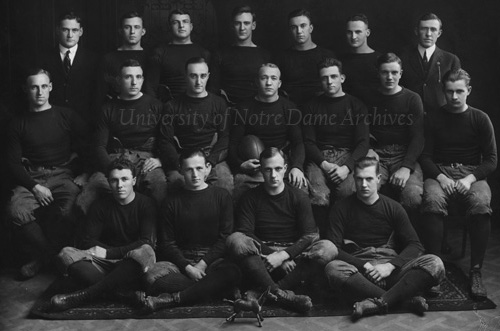
Back Row: Ass't coach Edwards, Emmett Keefe, Ray Eichenlaub, Albert King, Freeman Fitzgerald, Charles Finegan, Coach Jesse Harper; Middle: Ralph Lathrop, Keith Jones, Joe Pliska, Captain Knute Rockne, Gus Dorais, Fred Gushurst, Al Feeney;
Front row: Allen Elward, Alfred Bergman, Bill Cook, Art Larkin
Harper had cobbled together an ambitious schedule.
- It started with three October games at home against small schools: Ohio Northern, South Dakota, and Alma.
- Then Harper's boys hit the road for the last four, starting with trips to West Point and Penn State and ending with a foray southwest to St. Louis to play Christian Brothers and to Austin TX to meet the Longhorns.
Notre Dame (not yet commonly called the "Fighting Irish") breezed through the first three games by a combined score of 169-7.
- Dorais got off to a shaky start against Ohio Northern - his first three passes were intercepted. But his fourth, to E Allen Elward, resulted in a touchdown, one of many in the 87-0 romp.
- Two weeks later, South Dakota was expected to provide a more formidable test. Ticket sales were heavy as alumni came in from Chicago, Indianapolis, Fort Wayne, and other midwest cities. The Coyotes outweighed the Irish by 35 pounds per man. Furthermore, Rockne would not play because of injury. Still, Notre Dame prevailed 20-7 in "the hardest football game played on Cartier field in many years," according to the Notre Dame newspaper. ND's last and clinching touchdown came on a long pass by Dorais.
- The following Saturday, one of Harper's former schools, Alma, provided the opposition. Not wishing to reveal any of the "fancy" new formations he had designed for Army and Penn State, Harper kept the game plan simple against the outmanned Scots, who fell 62-0 as Knute returned to action.
That cleared the decks for the 1,000 mile trip to meet the Cadets.
- West Point was 3-0 with victories over Stevens (34-0), Colgate (7-6), and Tufts (2-0).
- They originally considered their first ever meeting with Notre Dame a "breather" before the big Navy clash but heard reports out of the Midwest that made them take the contest more seriously.
- Coach Charles Daly brought in extra coaches, alumni of West Point, Harvard, and Michigan, to help prepare the team.
- Meanwhile, Harper drilled his team in the passing and running plays he wanted to employ against the Cadets.
The entire Notre Dame student body gathered early on Thursday, October 30, to send their "band of nineteen gold and blue warriors" on their way.
- Harper spoke to the throng: We are going for victory, but of course I am not going to make any forecast of the result. Chances seem about even, but with chances even, Notre Dame always wins. I consider this the hardest game on our schedule, and the men are going to fight a battle of their lives. The strength of the cadets is a mystery to me so I have trained my men to put up the bitterest fight of their lives in Saturday's game.
- Jesse had bargained with Army officials to raise the payment for the game from $400 to $1000. Even then, he barely covered expenses despite the fact that West Point provided room and board. Notre Dame would earn a profit of $154.50 from the game.
- To illustrate the austere circumstances, the traveling team brought only 14 pairs of cleats for 19 players. Meals on the train consisted of sandwiches packed by the nuns in the college cafeteria.
- The West Point equipment manager noticed that the visitors were poorly equipped. I remember being asked by many of the players, who were in the process of dressing before the game, if they coudl obtain some ankle wraps, knee guards, supporters, extra shoe strings, several pairs of shoes and two extra pairs of football pants.
Despite the odds against them, the westerners entered the clash with a positive outlook.
- Backup C Voelkers recalled: We were a confident crew. We knew we were going to win because we had worked hard on a series of forward pass plays. The pass hadn't been used much until then, probably because no coach until Harper saw the possibilities of it. He developed it even more later.
- On the other side, Army hoped to win "by a decisive score to secure confidence to themselves and their supporters," according to a special report to the New York Times.
- The Times article continued: The Westerners are expected to flash an open field attack and the Cadets are wondering what it consists of. The visitors seem particularly heavy and look to outweigh the Army by at least ten pounds to the man. Their workout to-day was in secret as was that of the Cadets, who took the field after Notre Dame had retired.
One of the most important games in football history kicked off at 3 PM Saturday, November 1, 1913.
To be continued ...
Reference: Notre Dame and the Game That Changed Football: How Jesse Harper Made the Forward Pass a Weapon and Knute Rockne a Legend, Frank P. Maggio (2007)
Rockne of Notre Dame: The Making of a Football Legend, Ray Robinson (1999)
Top of Page
|

Knute Rockne
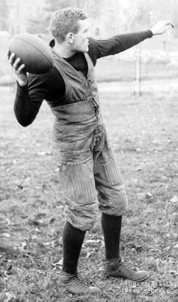
1913 Passer - note roundness of football
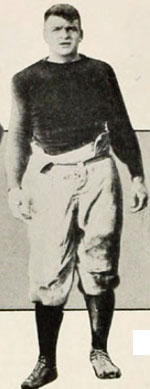
Ray Eichenlaub
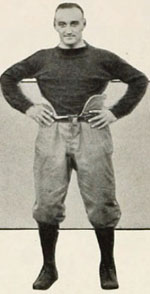
Joe Pliska
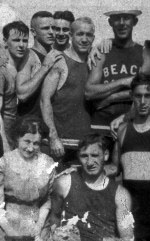
Knute Rockne and friends at Cedar Point, summer of 2013
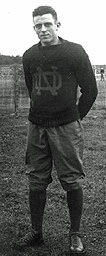
Gus Dorais
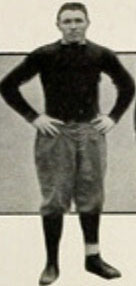
Al Elward
|
Jesse Harper, the Man Who Put Notre Dame on the Football Map - III
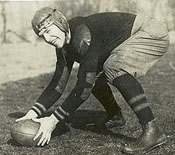
John McEwan
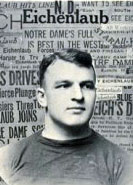
Ray Eichenlaub

Charles Finegan

Vernon Prichard
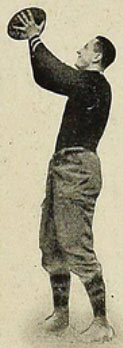
Louis Merillat
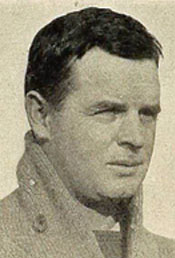
Army Coach Charles Daly 1913
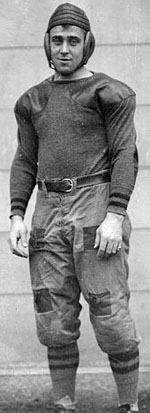
Army captain Ben Hoag

Frank Milburn
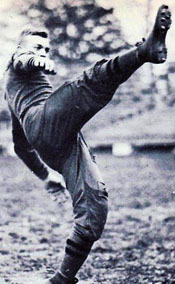
Dwight Eisenhower
|
November 1, 1913, was a cold, raw day at West Point.
- 3,000 to 5,000 spectators, depending on whose estimate you choose to accept, gathered to watch the Cadets host Notre Dame.
- With free admission, the crowd consisted almost entirely of cadets and Army fans.
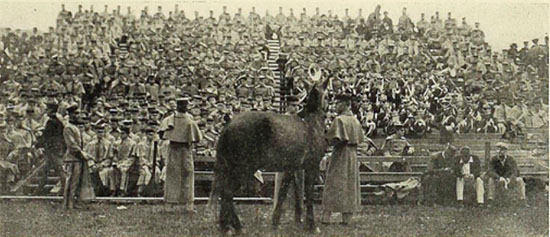
1913 Army Corps of Cadets and Band with the Army Mule The visiting captain, Knute Rockne, correctly called the toss and elected to receive.
- 6'4" John McEwan kicked off to Gus Dorais, who took only a few steps before being buried under a pile of Cadets.
- On the second play, Notre Dame fumbled, and Army recovered. But nothing came of the break as each team was penalized for holding. So Paul Hodgson punted to Dorais on the five, and he wiggled to the 35 before going down.
- After Joe Pliska gained five around end, Dorais tried his first pass (always referred to as a "forward pass" at the time). But it fell incomplete. So Dorais punted to midfield.
- When Hodgson punted back, Dorais fumbled when tackled hard, and Laurence Meacham fell on the ball for Army. But again, the Cadets could not take advantage.
- FB Ray Eichenlaub and HB Charles Finegan tore big holes in Army's front. Dorais tried a second pass, but it too failed. So he went back to the ground game. Eichenlaub and Pliska succeeded in carrying the ball to the 25.
Now came the play that shocked the Army team and their crowd.
- Dorais dropped back and fired a pass to Rockne, who caught the ball "a few yards from the goal line" (New York Times, 11/2/1913) and took in for a touchdown. Dorais's PAT made it 7-0. A pass of that length to a receiver on the dead run was unheard of in 1913.
Years later, Rockne recalled the first touchdown against Army.
After one fierce scrimmage, I emerged limping as if hurt. On the next three plays ..., I limped down the field, acting as if the thing farthest from my mind was to receive a forward pass. After the third play, the Army halfback covering me figured I wasn't worth watching. Even as a decoy, he figured I was harmless.
Finally Dorais called my number, meaning that he was to throw a long forward pass to me as I ran down the field and out toward the sideline. I started limping down the field, and the Army halfback covering me almost yawned in my face, he was that bored. I put on full speed and left him standing there flatfooted. I raced across the Army goal line as Dorais whipped the ball, and the grandstands roared at the completion of a 40-yard pass [actually 25 according to the NY Times]. Everybody seemed astonished. There had been no hurdling, no tackling, no plunging, no crushing of fiber and sinew. Just a long-distance touchdown by rapid transit.
- Before the period ended, Dorais "got off several spectacular forward passes to Pliska and Rockne." But neither contributed to a touchdown drive.
- Gus finished the quarter with six completions in a row.
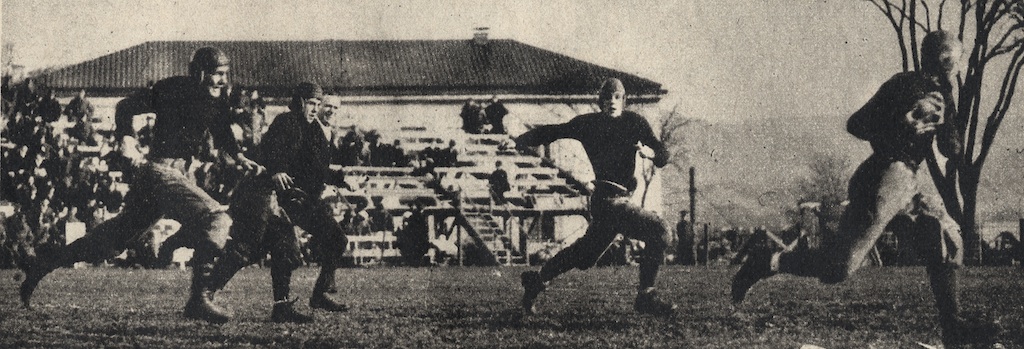 Knute Rockne scores the first touchdown against Army. Army tried its hand at passing in the second quarter.
- Vernon Prichard, Army's QB, connected with Lovett to the Notre Dame 15. Hodgson and Leland Hobbs carried the ball the rest of the way, with Hodgson hurling himself over the goal line.
- Roscoe Woodruff rushed in as a "pinch kicker" and booted the ball over the crossbar to tie the score.

Woodruff Kicks Goal for Army
- When the Cadets got the ball back, Rockne tackled E Louis Merillat so hard "that he was laid out, but came back into the game smiling just as soon as he got his wind again."
- Prichard then drove the Army team at top speed, and a fine forward pass, which he threw to [John] Jouett, landed the leather on the five-yard line. Three times Hodgson and Hobbs tried to batter their way over the goal line, but got only as far as the one-yard mark. Here Notre Dame was penalized for holding, and the Army fortunately got a first down. Still, the defense refused to yield. Hodgson slammed into the line twice only to be repelled. Finally, Prichard hurled himself into the end zone as the crowd "went wild with joy." Hoge's kick misfired to leave the score 13-7 Army.
West Point's joy was short-lived.
- Starting from the 15, ND "sailed serenely" down the field for a touchdown.
- Dorais fell back and the Notre Dame team spread out across the field. Dorais hurled the ball high and straight for twenty-five yards, and Rockne, on the dead run, grabbed the ball out of the air and was downed in midfield.
- Then Gus targeted Pliska. The ball went high and straight, and Pliska was far out of the Army's reach when he caught it. The partisan Army crowd for the moment forgot that the Army was being defeated, and burst forth in a sincere cheer for the marvelous little quarter back Dorais and his record toss of thirty-five yards.
- The next throw went to Finegan who was downed a few yards from the goal. Pliska then went off tackle for the six. Dorais booted the go-ahead point. 14-13 Notre Dame
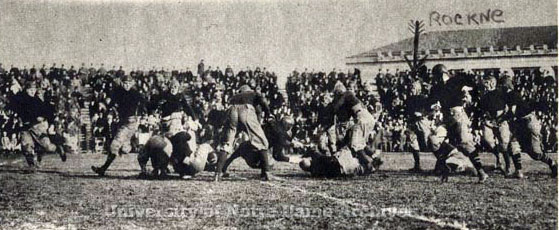 Notre Notre Dame- Army action Notre Dame almost added another touchdown before halftime.
- The visitors had the ball at the Army 43 "close to the east side of the gridiron."
- Dorais barked out a signal, and the whole western back field and ends rushed across to the west side of the field.
- Gus took the snap and ran back several yards before setting himself and launching a pass far and straight through the air for nearly 40 yards, soaring toward the outstretched hands of Rockne. If this pass had been executed it would have been a dazzling trick, but just as Rockne was about to grab the ball Prichard hurled himself high over the Notre Dame Captain's head and caught the ball.
- That ended the half.

Gus Dorais kicking The second half started the same way as the first with the ball seesawing up and down the field.
- We don't know what Coach Charlie Daly, a former player at both Harvard and West Point, told his Cadets, but they could no longer treat the opponent as a pushover. They came out much more determined and spread their defense to stop Dorais's passes. So Notre Dame reverted to its running game.
- Gus attempted to kick a goal from midfield, but the ball rolled down to the goal line. Army proceeded to pound its way to the Notre Dame 15. A fresh back, Frank Milburn, carried twice for 12y and a holding penalty moved the pigskin even closer.
- Hodgson plunged into the line but "was lifted bodily by Rockne, who hurled him back for a loss." Millburn gave it a try but suffered another loss. So Prichard threw a pass toward Merrilatt in the end zone. But the alert Dorais intercepted to preserve ND's lead.
- The quarter ended with neither side changing the scoreboard.
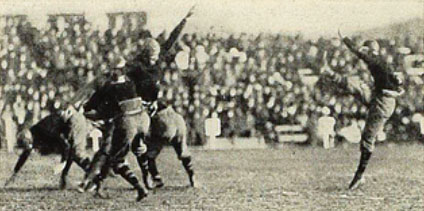 Army
Army protects its punter vs Notre Dame. The final period was all Notre Dame.
- The physical conditioning that Harper had stressed began to pay dividends. Jesse bragged in later years about his "iron men" not calling a single timeout in the game and using only one substitute as opposed to twelve for Army.
C John Voelkers recalled: That iron man stuff was no accident. ... Harper was a stickler on condition. We had two, sometimes three scrimmages every week - rough ones. They often lasted until it was too dark to see, and always ended with wind sprints and a run to the locker room. The scrimmages were harder than the game, and longer. We were always glad when the day of the game arrived because it meant a respite from scrimmages.
- Finegan dashed 25y around end, and "several bull-like rushes by Eichenlaub" resulted in a touchdown. Dorais kicked the goal. Notre Dame 21 Army 13
- When the visitors got the ball back, "the forward passes began to sail around in the air again." Before Army knew what was happening, Pliska galloped to the five before several tacklers brought him down. Dorais then flipped to Joe for another six-pointer. Dorais booted the ball over the cross-bar with graceful ease. Notre Dame 28 Army 13
- Notre Dame's thirst for points was not quenched yet. Finegan took a pass to the Army 30, and the Cadets were penalized 15y "for off side play." ND then "began to hammer and hammer relentlessly at the tiring line of stubborn soldiers." "Fierce plunges" by Finegan and Eichenlaub slowly but surely advanced the ball to the goal line, with the big fullback plunging over.
- Final score: Notre Dame 35 Army 13
Cadet Dwight Eisenhower, out with an injury and serving as an undergraduate coach, sat frustrated on the Army bench throughout the game with his roommate, Omar Bradley. Both would achieve the army's highest rank, five stars, and lead the United States to victory in World War II.
Back in South Bend, the Notre Dame students crowded around the offices of the South Bend News-Times awaiting telegraph bulletins.
- For a long time, all they knew was the halftime score. After an agonizing delay, the final score came through.
- As the News-Times reported, Pandemonium broke loose among the students. With wild shrieks of delight they turned into Main Street and in a few moments 300 had gathered to celebrate the overwhelming victory. A snake dance was quickly formed and the men invaded Michigan Street winding from curb to curb and yelling like demons.
Headlines shouted the result across the nation the next day.
- NOTRE DAME'S OPEN PLAY AMAZES Army (New York Times)
- LONG PASSES AND OPEN FIELD PLAY PROVES TOO MUCH FOR THE CADETS (Tulsa World)
- NOTRE DAME MAKES WEST POINT ELEVEN LOOK LIKE NOVICES (Kalamazoo Gazette)
- NOTRE DAME OUTCLASSES THE CADETS IN EVERY DEPARTMENT (Washington Evening Star)
The Notre Dame team left West Point immediately after the game.
- They arrived in Buffalo Sunday morning and went on a sightseeing trip to Niagara Falls.
- The contingent received a heroes' welcome when they returned to South Bend Monday morning. Dorais: When we got out of our day coach at the South Bend railroad station, we found most of the town waiting for us. There was a parade with several bands and plenty of red fire, and, of course, captain Knute Rockne was called on for a speech. He made one, but he was so nervous and embarrassed that he twisted most of the buttons off his coat while he was doing it; and no one in the audience could understand a word of what he said.
- Rockne would, of course, improve his speechmaking skills to the point where he perfected the inspirational pregame and halftime talks when he coached the Fighting Irish.
Continued below ...
References : Notre Dame and the Game That Changed Football: How Jesse Harper Made the Forward Pass a Weapon and Knute Rockne a Legend, Frank P. Maggio (2007)
Rockne of Notre Dame: The Making of a Football Legend, Ray Robinson (1999)
Top of Page
|
Jesse Harper, the Man Who Put Notre Dame on the Football Map - IV
It is no exaggeration to say that the reputation of a small Catholic school in Indiana as a football power began when Notre Dame defeated Army 35-13 through the use of the forward pass.
- But many a school has made a splash nationally only to sink back to obscurity within a few years.
- The challenge is to maintain the edge, and Jesse Harper did that along with his star E and successor, Knute Rockne.
After returning from West Point, the Irish had to go from the frying pan into the fire.
- The next Saturday, they traveled to Penn State to play what turned out to be their toughest game of 1913.
- The Nittany Lions had not been scored upon on their home field in five years.
- Well aware of what their visitors had done at Army (although scouting opponents in advance was not in vogue yet), PSU worked on their own forward-passing skills. Senior QB Gene "Shorty" Miller (all 5'5" of him) had started all four years and had rushed for 250y against Carnegie Tech earlier in the '13 season to set a school record that lasted 68 years. It was reported that he also could "put the ball just where he wants it" when he passed.
An "unusually large crowd" gathered for homecoming in State College PA.
- The Lions hoped to show the sporting world that they had a team worthy of national respect too.
- But you have to score to win, and Miller & Company couldn't dent the Fighting Irish defense until the visitors established a 14-point led.
- Dorais set up the first touchdown with a 35y run in Q2. Then, on the next snap, he threw a 40y touchdown pass to Rockne.
- The visitors scored what proved to be the winning touchdown in Q3 on a long run by FB Ray Eichenlaub.
- Penn State got on the scoreboard late in Q3 on a pass from Miller but could muster no more. Final: Notre Dame 14 Penn State 7
Notre Dame ended the season with a two-game road trip to the southwest.
- They polished off Christian Brothers College in St. Louis 20-7 as Harper kept Dorais, Eichenlaub, and C Albert Feeney on the bench to start the game to conserve them for the next challenge.
- The Irish then became the first school north of the Mason-Dixon line to play Texas. The Longhorns were considered the top team in the region because of their victories over Kansas A&M and Oklahoma. Several days of rain made the field muddy and slow for the Thanksgiving Day clash. But the Fighting Irish prevailed anyway, 30-7.
- Other schools, including LSU, tried to schedule a post-season game with the traveling Catholics, but nothing was worked out.
- Thus did Notre Dame end its first undefeated season on the gridiron (7-0).
Despite the loss of Dorais and Rockne, Harper continued to have success.
- Notre Dame won 27, lost 5, and tied 1 in his remaining four seasons as head man.
- He retired after the 1917 season and returned to his ranch in Kansas. His star pupil, Rockne, replaced him at the helm.
- Ironically, Harper's land was not far from where Rockne died in a plane crash in 1931 after cementing Notre Dame's reputation as a football power with a 105-12-5 record over 13 seasons. Included were five undefeated seasons (1919, 1920, 1924, 1929, and 1930) and a Rose Bowl victory with the famous "Four Horsemen" in 1924.
- The university persuaded Harper to fill Rock's shoes as athletic director, a position he held until 1934 when Elmer Layden, one of the Four Horsemen, became coach and AD.
References : Notre Dame and the Game That Changed Football: How Jesse Harper Made the Forward Pass a Weapon and Knute Rockne a Legend, Frank P. Maggio (2007)
Top of Page
|
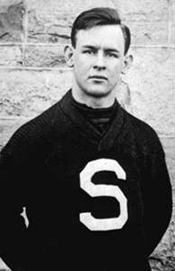
Shorty Miller

Knute Rockne 1913
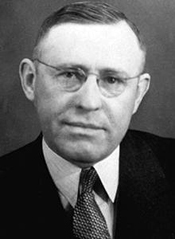
AD Jess Harper
|
|
|





 Knute Rockne scores the first touchdown against Army.
Knute Rockne scores the first touchdown against Army. Notre Notre Dame-Army action
Notre Notre Dame-Army action


























